|
|
| |
|
|
| |
|
|
|
|
| |
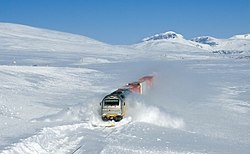 |
| Norwegian train
plowing through drifted snow. |
Snow
Snow is a form of ice. Snow forms when water in the
atmosphere becomes frozen. Snow comes in all different
shapes and sizes.
At the freezing point of water (0° Celsius, 32° Fahrenheit),
snow melts and becomes liquid water. Sometimes, the snow
will melt very fast and become water vapor. This is called
sublimation. The opposite, where water vapor becomes snow,
is called deposition.
Snow is used for some winter sport activities like skiing
and sledding. Sometimes people make artificial snow so they
can ski. People also commonly build things out of snow for
fun.
Snow can also be dangerous, as it can lower visibility and
make driving very difficult. When it snows, the snow will
melt a little during the daytime and freeze again at night.
This makes ice which can make driving conditions very
treacherous. Snow plows are used to remove snow from roads
to make driving easier and safer. Also, sand or salt may be
added to the road to help tires grip the road. When salt is
mixed with snow, the snow will melt more easily. This is
because salt water has a lower melting point than fresh
water (water without salt).
A blizzard is a dangerous type of a snowstorm. A blizzard
produces strong winds that keep the snow in the air, thus
reducing visibility. Sometimes it produce thundersnow, which
is snow with lightning and thunder. |
|
 |
| Freshly fallen
snowflakes. |
Snowflakes
Snow crystals form when tiny supercooled cloud droplets
(about 10 μm in diameter) freeze. These droplets are
able to remain liquid at temperatures lower than
Template:C to F, because to freeze, a few molecules in
the droplet need to get together by chance to form an
arrangement similar to that in an ice lattice; then the
droplet freezes around this "nucleus." Experiments show
that this "homogeneous" nucleation of cloud droplets
only occurs at temperatures lower than Template:C to F.
In warmer clouds an aerosol particle or "ice nucleus"
must be present in (or in contact with) the droplet to
act as a nucleus. Our understanding of what particles
make efficient ice nuclei is poor — what we do know is
they are very rare compared to that cloud condensation
nuclei on which liquid droplets form. Clays, desert dust
and biological particles may be effective, although to
what extent is unclear. Artificial nuclei include silver
iodide and dry ice, and these form the basis of cloud
seeding.
Once a droplet has frozen, it grows in the
supersaturated environment, which is one where air is
saturated with respect to ice when the temperature is
below the freezing point. The droplet then grows by
diffusion of water molecules in the air (vapour) onto
the ice crystal surface where they are collected.
Because water droplets are so much more numerous than
the ice crystals due to their sheer abundance, the
crystals are able to grow to hundreds of micrometres or
millimetres in size at the expense of the water
droplets. This process is known as the Wegner-Bergeron-Findeison
process. The corresponding depletion of water vapour
causes the droplets to evaporate, meaning that the ice
crystals grow at the droplets' expense. These large
crystals are an efficient source of precipitation, since
they fall through the atmosphere due to their mass, and
may collide and stick together in clusters, or
aggregates. These aggregates are snowflakes, and are
usually the type of ice particle that falls to the
ground. Guinness World Records list the world’s largest
snowflakes as those of January 1887 at Fort Keogh,
Montana; allegedly one measured 38 cm (15 inches) wide.
The exact details of the sticking mechanism remains
controversial. Possibilities include mechanical
interlocking, sintering, electrostatic attraction as
well as the existence of a "sticky" liquid-like layer on
the crystal surface. The individual ice crystals often
have hexagonal symmetry. Although the ice is clear,
scattering of light by the crystal facets and
hollows/imperfections mean that the crystals often
appear white in color due to diffuse reflection of all
spectrum of light by the small ice particles.
Geometry
Ice crystals formed in the appropriate conditions are
often thin and flat. These planar crystals may be in the
shape of simple hexagons, or if the supersaturation is
high enough, develop branches and dendritic (fern-like)
features and have six approximately identical arms. The
sixfold symmetry arises from the hexagonal crystal
structure of ordinary ice, the branch formation is
produced by unstable growth, with deposition occurring
preferentially near the tips of branches.
The shape of the snowflake is determined broadly by the
temperature and humidity at which it is formed. Rarely,
at a temperature of around −2 °C (28 °F), snowflakes can
form in threefold symmetry — triangular snowflakes. The
most common snow particles are visibly irregular,
although near-perfect snowflakes may be more common in
pictures because they are more visually appealing.
Planar crystals (thin and flat) grow in air between 0 °C
(32 °F) and −3 °C (27 °F). Between −3 °C (27 °F) and −8
°C (18 °F), the crystals will form needles or hollow
columns or prisms (long thin pencil-like shapes). From
−8 °C (18 °F) to −22 °C (−8 °F) the shape reverts back
to plate-like, often with branched or dendritic
features. The maximum difference in vapour pressure
between liquid and ice is at about −15 °C (5 °F) where
crystals grow most rapidly at the expense of the liquid
droplets. At temperatures below −22 °C (−8 °F), the
crystal development becomes column-like, although many
more complex growth patterns also form such as
side-planes, bullet-rosettes and also planar types
depending on the conditions and ice nuclei. If a crystal
has started forming in a column growth regime, at around
−5 °C (23 °F), and then falls into the warmer plate-like
regime, then plate or dendritic crystals sprout at the
end of the column, producing so called "capped columns."
No two snowflakes are alike. It is more likely that two
snowflakes could become virtually identical if their
environments were similar enough. The American
Meteorological Society has reported that matching snow
crystals were discovered in Wisconsin in 1988 by Nancy
Knight of the National Center for Atmospheric Research.
The crystals were not flakes in the usual sense but
rather hollow hexagonal prisms. |
|
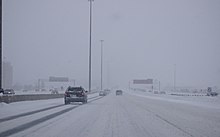 |
| Winter conditions on
Ontario Highway 401 in Toronto due to a
snowsquall. |
Types
Types of snow can be designated by the shape of its
flakes, its rate of falling, and by how it collects on
the ground. Snowfall's intensity is determined by
visibility. When the visibility is over 1 kilometre
(0.62 mi), snow is determined to be light. Moderate snow
describes snowfall with visibility restrictions between
.5 kilometres (0.31 mi) and 1 kilometre (0.62 mi). Heavy
snowfall describes conditions when visibility is
restricted below .5 kilometres (0.31 mi). A blizzard and
snowstorm indicate heavy snowfalls, with blizzards
defined by having high winds during their heavy
snowfall. Snow flurries are used to describe the
lightest form of snow showers. Types which fall in the
form of a ball due to melting and refreezing cycles,
rather than a flake, are known as graupel, with sleet
and snow pellets as types of graupel associated with
wintry precipitation. Once on the ground, snow can be
categorized as powdery when fluffy, granular when it
begins the cycle of melting and refreezing, and
eventually ice once it packs down into a dense drift
after multiple melting and refreezing cycles. When
powdering, snow drifts with the wind, sometimes to the
depth of several meters. After attaching to hillsides,
blown snow can evolve into a snow slab, which is an
avalanche hazard on steep slopes. A frozen equivalent of
dew known as hoar frost forms on a snow pack when winds
are light and there is ample low-level moisture over the
snow pack.
Density
Snow remains on the ground until it melts or sublimates.
The water equivalent of a given amount of snow is the
depth of a layer of water having the same mass and upper
area. For example, if the snow covering a given area has
a water equivalent of 50 centimetres (20 in), then it
will melt into a pool of water 50 centimetres (20 in)
deep covering the same area. This is a much more useful
measurement to hydrologists than snow depth, as the
density of cool freshly fallen snow widely varies. New
snow commonly has a density of around 8% of water. This
means that 13 inches (330 mm) of snow melts down to 1
inch (25 mm) of water.
Once the snow is on the ground, it will settle under its
own weight (largely due to differential evaporation)
until its density is approximately 30% of water.
Increases in density above this initial compression
occur primarily by melting and refreezing, caused by
temperatures above freezing or by direct solar
radiation. In colder climates, snow lies on the ground
all winter. By late spring, snow densities typically
reach a maximum of 50% of water. Spring snow melt is a
major source of water supply to areas in temperate zones
near mountains that catch and hold winter snow,
especially those with a prolonged dry summer. In such
places, water equivalent is of great interest to water
managers wishing to predict spring runoff and the water
supply of cities downstream. Measurements are made
manually at marked locations known as snow courses, and
remotely using special scales called snow pillows. When
the snow does not all melt in the summer it evolves into
firn, where individual granular elements become more
spherical in nature, evolving into a glacier as the ice
flows downhill. |
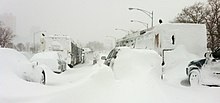 |
| Traffic stranded in
a 2011 Chicago snowstorm. |
Regional characteristics
Since fresh snow reflects 90 percent or more of
short-wave radiation, and radiates energy nearly
completely further into the infrared spectrum, little
energy from the sun is converted into heat from the new
snow, and much heat is lost. Many rivers originating in
mountainous or high-latitude regions have a significant
portion of their flow from snowmelt. This often makes
the river's flow highly seasonal resulting in periodic
flooding. In contrast, if much of the melt is from
glaciated or nearly glaciated areas, the melt continues
through the warm season, mitigating that effect. The
world record for the highest seasonal total snowfall was
measured in the United States at Mount Baker Ski Area,
outside of the town Bellingham, Washington during the
1998–1999 season. Mount Baker received 2896 cm (1,140
inches) of snow, thus surpassing the previous record
holder, Mount Rainier, Washington, which during the
1971–1972 season received 2850 cm (1,122 in.) of snow.
Effects on human society
Substantial snowfall can disrupt public infrastructure
and services, slowing human activity even in regions
that are accustomed to such weather. Air and ground
transport may be greatly inhibited or shut down
entirely. Populations living in snow-prone areas have
developed various ways to travel across the snow, such
as skis, snowshoes, and sleds pulled by horses, dogs, or
other animals and later, snowmobiles. Basic utilities
such as electricity, telephone lines, and gas supply can
also fail. In addition, snow can make roads much harder
to travel and vehicles attempting to use them can easily
become stuck. The combined effects can lead to a "snow
day" on which gatherings such as school, work, or church
are officially canceled. In areas that normally have
very little or no snow, a snow day may occur when there
is only light accumulation or even the threat of
snowfall, since those areas are unprepared to handle any
amount of snow. In areas near mountains, people have
harvested snow and stored it as layers of ice covered by
straw or sawdust in icehouses. This allowed the ice to
be used in summer for refrigeration or medical uses.
Agriculture
Snowfall can be beneficial to agriculture by serving as
a thermal insulator, conserving the heat of the Earth
and protecting crops from subfreezing weather. Some
agricultural areas depend on an accumulation of snow
during winter that will melt gradually in spring,
providing water for crop growth. If it melts into water
and refreezes upon sensitive crops, such as oranges, the
resulting ice will protect the fruit from exposure to
lower temperatures. |
|
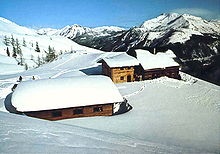 |
| Snow accumulation on
building roofs. |
Brightness
Snow blindness (also known as ultraviolet keratitis,
photokeratitis or niphablepsia) is a painful eye
condition, caused by exposure of unprotected eyes to the
ultraviolet (UV) rays in bright sunlight reflected from
snow or ice. Fresh snow reflects about 80% of UV
radiation. This condition is a problem in polar regions
and at high altitudes, as with every thousand feet
(approximately 305 meters) of elevation (above sea
level), the intensity of UV rays increases by four
percent. Snow's large reflection of light makes night
skies much brighter. However, when there is also cloud
cover because snow is falling, light is then reflected
back to the ground. This greatly amplifies light emitted
from city lights, causing the 'bright night' effect. A
similar brightening effect occurs in a reduced version
when no snow is falling when there is a full moon and a
large amount of snow. |
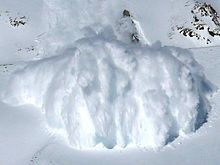 |
| A powder snow
avalanche. |
Damage
When heavy, wet snow with a snow-water equivalent (SWE)
ratio of between 6:1 and 12:1 and a weight in excess of
9.8 pounds per square foot piles onto trees still in
full leaf during the early autumn, significant tree
damage occurs on a scale usually associated with
hurricanes. An avalanche can occur when excessive snow
has accumulated on a mountain and there is a sudden
change of temperature, which causes the snow to rush
downhill en masse. Preceding an avalanche is a
phenomenon known as an avalanche wind caused by the
approaching avalanche itself, which adds to its
destructive potential. Large amounts of snow which
accumulate on top of man-made structures can lead to
structural failure.
Recreation |
- Many winter sports, such as skiing,
snowboarding, snowmobiling and snowshoeing depend upon
snow. Where snow is scarce but the temperature is low
enough, snow cannons may be used to produce an adequate
amount for such sports.
- Children (also adults and
occasionally other species) can play on a sled or ride
in a sleigh.
- Snow can be used to explore unknown
or uncharted areas such as dense forest, fields, and
marshlands because, barring heavy snowfall or blizzards,
a person's footsteps remain a visible lifeline.
- One of the recognizable recreational
uses of snow is in building snowmen. A snowman is
created by making a man shaped figure out of snow -
often using a large, shaped snowball for the body and a
smaller snowball for the head which is often decorated
with simple household items - traditionally including a
carrot for a nose, and coal for eyes, nose and mouth;
occasionally including old clothes such as a top hat or
scarf.
- Snow can be used to make snow cones,
which are usually eaten in the summer months when
temperatures flare above 100 degrees Fahrenheit.
- Snow can be used to build defensive
snow forts for outdoor games such as Capture the flag or
for snowball fights.
- The world's biggest snowcastle, the
SnowCastle of Kemi, is built in Kemi, Finland every
winter.
- Since 1928 Michigan Technological
University in Houghton, Michigan has held an annual
Winter Carnival in mid-February, during which a large
Snow Sculpture Contest takes place between various
clubs, fraternities, and organizations in the community
and the university. Each year there is a central theme,
and prizes are awarded based on creativity.
- Snowball softball tournaments are
held in snowy areas, usually using a bright orange
softball for visibility, and burlap sacks filled with
snow for the bases.
|
 Kiddle: Snow Kiddle: Snow
Wikipedia: Snow |
|
|
|
|
|
|
|
|
|
|
|
|
|
|
|
|
Search Fun Easy English |
|
|
|
|
|
|
|
|
|
|
|
|
|
|
|
About
Contact
Copyright
Resources
Site Map |